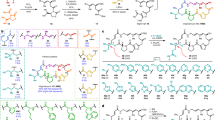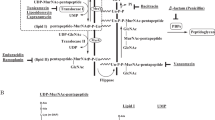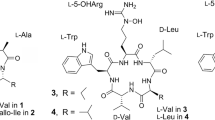Abstract
AGROCIN 84 (Fig. 1(1)) is the active factor1 in the biological control of crown gall, a plant cancer induced by certain strains of Agrobacterium. Growth inhibition by agrocin 84 has been correlated with pathogenicity2–5 and the presence of a nopaline (N2-(1,3-dicarboxypropylarginine)) tumour-inducing plasmid3–5. Characterisation of agrocin 84 as a disubstituted adenine nucleotide6 has been reported and a proposed7 peptide structure has been retracted8. What are those salient features of agrocin 84 that determine its remarkable bacteriocin-like specificity towards cancer-inducing strains of Agrobacterium? The structural evidence reported here shows that a 5′-phosphoryl linkage from the ‘fraudulent’ nucleoside core 9-(3′-deoxy-β-D-threo-pentofuranosyl) adenine6 to the amide group of D-threo-2,3-dihydroxy-4-methylpentanamide (Fig. 1(6)) is required for antibiotic activity, but bacteriocin-like specificity is conferred by a D-glucofuranosyloxyphosphoryl substituent at N6 of adenine. Agrocin 84 seems to be the harbinger of a series of highly specific nucleotide bacteriocins, which behave as molecular ‘Trojan horses’.
This is a preview of subscription content, access via your institution
Access options
Subscribe to this journal
Receive 51 print issues and online access
$199.00 per year
only $3.90 per issue
Buy this article
- Purchase on Springer Link
- Instant access to full article PDF
Prices may be subject to local taxes which are calculated during checkout
Similar content being viewed by others
References
Kerr, A. & Htay, K. Physiol. Pl. Path. 4, 37–44 (1974).
Roberts, W. P. & Kerr, A. Physiol. Pl. Path. 4, 81–92 (1974).
Watson, B., Currier, T. C., Gordon, M. P., Chilton, M. & Nester, E. W. J. Bact. 123, 255–264 (1975).
Engler, G., Holsters, M., Van Montague, M., Schell, J., Hernalsteens, J. P. & Schilperoort, R. Molec. gen. Genet. 138, 345–349 (1975).
Van Larabeke, N. et al. Nature 255, 742–743 (1975).
Roberts, W. P., Tate, M. E. & Kerr, A. Nature 265, 379–81 (1977).
McCardell, B. & Pootjes, C. F. Antimicrob. Agents Chemother. 10, 498–502 (1976).
Thompson, R. J., Hamilton, R. H. & Pootjes, C. F. Plant Physiol. Suppl. 59(6), 110 (1977).
Braun, L. Monatsh. Chem. 17, 207–224 (1896).
Stonier, T. J. Bact. 79, 889–898 (1960).
Meyers, J. A., Sanchez, D., Elwell, L. P. & Falkow, S. J. Bact. 127, 1529–1537 (1976); J. Bact. 129, 1171 (1977).
Currier, T. C. & Nester, E. W. Analyt. Biochem. 66, 431–441 (1976).
Sciaky, D., Montoya, A. L. & Chilton, M. D. Plasmid. 1, 238–253 (1978).
Murphy, P. J. & Roberts, W. P. J. gen. Microbiol. (in the press).
Author information
Authors and Affiliations
Rights and permissions
About this article
Cite this article
TATE, M., MURPHY, P., ROBERTS, W. et al. Adenine N6-substituent of agrocin 84 determines its bacteriocin-like specificity. Nature 280, 697–699 (1979). https://doi.org/10.1038/280697a0
Received:
Accepted:
Issue Date:
DOI: https://doi.org/10.1038/280697a0
Comments
By submitting a comment you agree to abide by our Terms and Community Guidelines. If you find something abusive or that does not comply with our terms or guidelines please flag it as inappropriate.



